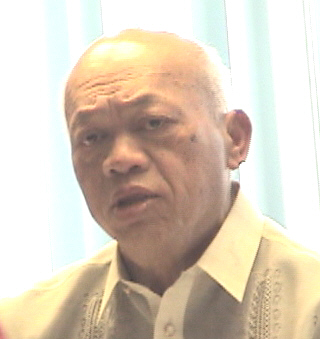Notes On
Modern Times and the Living Past
 by Sir Jose Sison Luzadas,
KGOR
by Sir Jose Sison Luzadas,
KGOR
A Quill of Romance, Revolution
and History
 Man’s
propensity to make improvements through innovations has been his hallmark.
The winds of change continue unchallenged. Many predicted that cybernetics
or computer technology some day will turn man’s early inventions as
obsolete “relics” of the past. A classic example is the quill pen as a
writing instrument. Man’s
propensity to make improvements through innovations has been his hallmark.
The winds of change continue unchallenged. Many predicted that cybernetics
or computer technology some day will turn man’s early inventions as
obsolete “relics” of the past. A classic example is the quill pen as a
writing instrument.
Today, we have a pen less
and paperless travel-friendly computer known as “LAPTOP”. It is
powerfully equipped with Internet and printer connectivity. Although it is
small in size and light in weight it has a deadly capability as the ideal
Weapon of Mass Distribution.
The ancient Sumerians and
the Egyptians never dreamed of data processing with the invention of
writing and introducing their alphabets in mind. The evolution started
with the use of crude tablets and sharp flint stones for in scripting.
Soon the cuneiform and hieroglyphics gave way to the modern western
alphabet, the papyrus, tree barks and parchments were discontinued and
replaced by paper. Since the introduction of the pen, ink and paper in the
seventh century thousands of literary masterpieces, philosophical and
scientific studies and volumes of political, economic and social tracts,
treatises and dissertations have been copied and preserved including the
surviving collection of books of antiquity in the ancient library at
Alexandria, Egypt.
Penna is a Greek word for
feather. The quill as we are more familiar is a flying feather of geese
that is cut in the shape of a sharp point (nib) for smooth and easy
scribbling. Since its appearance
in the seventh century the pen has affected our lives.
Without the quill pen,
Magna Carta is only a parchment! In 1215, a power grab occurred in the
woods of Runnymede, England as the barons forced their way to demand that
King John to surrender some of his royal prerogatives and recognize
his subjects in the exercise of their civil and political rights. Among
them is the right of the accused to confront his accusers. A person is
presumed innocent until after he is tried and proven guilty by his peers.
William Shakespeare
laboriously used the quill on his literary work, histories, tragedies,
comedies, drama, sonnets and poems. The same with Isaac Newton and his Law
of Gravity, Without the Quill, the prophesies and revelations of Michel
Nostradamus written five hundred years will not be known and popular
today. His growing cult followers are actively and faithfully watching
with believing eyes that his predictions including the terrorist 9/11
World Trade Building bombing in New York City are amazingly
“accurate”.
Many of the famous
speeches were originally written in calligraphic or formal handwriting
manuscripts. They bring to the readers a sense of history and romance,
arts and entertainment. We would be imagining Patrick Henry speaking in
the Virginia House of Burgess, “Give me liberty or give me
death” then he challenged England that ”Taxation without
representation is tyranny”. Or when Tom Paine was rallying the
colonials with stirring patriotic sentiments, “These are the times
that try men’s soul”, or reciting Jefferson’s “Declaration
of Independence document, “In the course of human events” “we hold these truths to be self-evident”. And
what about the US Constitution opening sentence? “We, the
People”.
Powerful words and
phrases, metaphors all designed to stir up emotions at a crucial time
during the War of independence. Another historic document worth quoting is
Abraham Lincoln’s presidential address he scribbled with his quill pen
aboard the train to Gettysburg, Pennsylvania, “Four scores and
seven years ago” and concluded with “That this
government of the people, by the people and for the people shall not
perish from this earth.”
The quill pen connection
has done much to enrich Philippine history, Without it, we will be
deprived of some interesting passages from Francisco Balagtas Baltazar’s
Florante At Laura, “O mahiganting langit.
bangis mo’y nasaan? Or
“Ang batang lumaki sa layaw karaniwa’y hubad”.
In the struggle for
democracy and independence, Dr Jose Rizal used the pluma da pavo. For two
decades he was busy with the quill annotating Morga’s work on
Pre-Spanish Philippines, writing and rewriting the manuscript until he was
satisfied with the last edition of the NOLI and FILI.
Rizal used the quill for
the last time when wrote a poem dedicated to his motherland that perhaps he
“forgot” or deliberately did not put the title for unknown reasons. It
was hidden in a kerosene lamp and smuggled out of Fort Santiago with the
help of his sister. It would be easier for us to remember and say “Adios
patria adorada” than “Huling Paalam”, ”My Last
Farewell’ or “Ultimo Adios”
Targeting
the government and pestering the Church or annoying the establishment was
the modus operandi adopted by Dr. Rizal in his struggle for social and
political reforms. Today, with the quill gone, the role of the Internet
and the LAPTOP is seen as vital instruments of change to advance human
rights, spread democracy, ease suffering and to pester the government. But
in spite of the big strides technology has come up with there is
no denying the vital role of the pen and the ink in the
continuum of our present civilization.
“Beneath
the rule of men entirely great, the pen is mightier than the sword”
(Lord Edward
Bulwer-Lytton, English novelist)
“One
drop of ink, thousands, perhaps millions… think”
(Lord
Byron, English poet)
(Please
Email
your comments to: luzadas@bellsouth.net
)
|

